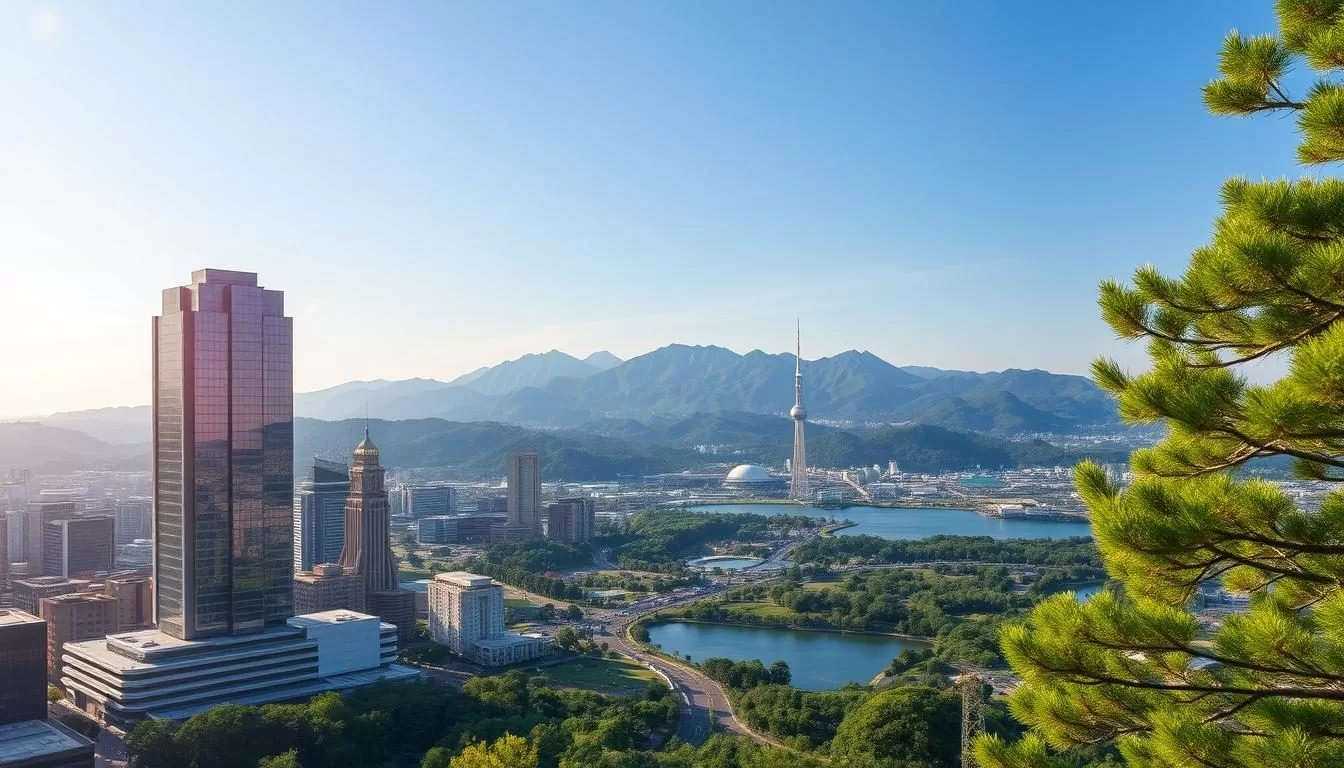Welcome to Tsukuba, a city located in the heart of Ibaraki Prefecture, Japan. Known as the “Science City,” Tsukuba is home to over 300 research institutions and universities, making it a hub for technological advancement and academic excellence.
Located just an hour’s train ride from Tokyo, Tsukuba offers a peaceful retreat while still providing a wealth of activities and attractions. You’ll discover a unique blend of cutting-edge research facilities, natural beauty, and cultural attractions that make this place worth visiting.
From sacred mountains and space centers to botanical gardens and interactive museums, Tsukuba has something for everyone. Whether you’re a science enthusiast, nature lover, or cultural explorer, this comprehensive guide will help you plan your perfect adventure in this fascinating area.
Discovering Tsukuba: Japan’s Science City
As Japan’s Science City, Tsukuba offers a fascinating mix of cutting-edge technology and traditional landscapes. Located about 60 kilometers northeast of Tokyo, this city has become a hub for scientific research and innovation.
Location and Background
Tsukuba is situated in the Ibaraki Prefecture, an area known for its rich history and natural beauty. The city’s strategic location makes it easily accessible from Tokyo and other major cities in Japan. With a population of over 230,000 residents, Tsukuba has evolved into a vibrant community that balances technological advancement with environmental conservation. The city’s background is deeply rooted in its academic and research institutions, including the University of Tsukuba, which is one of Japan’s most prestigious universities.

Unique Character of Tsukuba
What sets Tsukuba apart is its unique blend of science and nature. The city is home to numerous research facilities, including the Tsukuba Space Center, where visitors can learn about Japan’s space exploration history. At the same time, Tsukuba is surrounded by natural beauty, including Mount Tsukuba, which offers hiking trails and scenic views. This blend creates a fascinating contrast that makes Tsukuba an intriguing destination for various types of travelers.
Best Time to Visit
The best time to visit Tsukuba is during spring (March to May) when the cherry blossoms bloom, creating stunning displays throughout the city’s parks and along Mount Tsukuba. Alternatively, autumn (September to November) is another prime season to visit, with comfortable temperatures and vibrant fall foliage transforming the landscape. Each season offers unique attractions: summer brings festivals, while winter offers views of snow-capped Mount Tsukuba. Understanding the typical weather patterns throughout the year will help you pack appropriately for your visit.
- Spring (March to May) is ideal for cherry blossom viewing.
- Autumn (September to November) offers comfortable temperatures and beautiful fall foliage.
- Summer features various festivals and outdoor activities.
- Winter provides a serene landscape with snow-capped Mount Tsukuba.
The academic calendar also affects the city’s rhythm, with certain times being busier due to university events and scientific conferences. Planning your visit around these events can enhance your experience, whether you’re interested in science, nature, or cultural activities.
Why Tsukuba Should Be on Your Japan Itinerary
Tsukuba’s blend of scientific innovation and natural landscapes makes it an attractive alternative to more crowded Japanese cities. As you plan your trip to Japan, consider visiting this unique place that offers a refreshing escape from the typical tourist trail.
A Perfect Blend of Science and Nature
Tsukuba is known for its harmonious blend of scientific advancements and natural beauty. The city is home to numerous research institutions and technological facilities, earning it the nickname “Science City.” At the same time, it boasts beautiful parks, gardens, and the iconic Mount Tsukuba. This balance makes Tsukuba an appealing place for a wide range of visitors.
![]()
For instance, you can visit the Tsukuba Space Center to explore Japan’s space exploration history and then stroll through the serene Tsukuba Botanical Garden. This mix of science and nature provides a unique experience that sets Tsukuba apart from other destinations.
Accessibility from Tokyo
One of the significant advantages of Tsukuba is its accessibility from Tokyo. The city is easily reachable by train, making it an ideal day-trip or short-stay destination. The Tsukuba Express line connects Akihabara in Tokyo to Tsukuba in about 45 minutes, providing a convenient travel option for those based in the capital.
This proximity to Tokyo means you can enjoy the benefits of a less crowded area while still being within reach of the city’s amenities. Whether you’re looking for a quick escape or a longer, more leisurely visit, Tsukuba’s accessibility makes it an attractive choice.
Less Crowded Alternative to Popular Destinations
Compared to more famous locations in Japan, Tsukuba offers a significantly less crowded experience. The city’s attractions, such as Mount Tsukuba and the Tsukuba Expo Center, are popular but do not suffer from the overwhelming crowds found in places like Tokyo or Kyoto.
| Destination | Crowd Level | Main Attractions |
|---|---|---|
| Tsukuba | Low to Moderate | Mount Tsukuba, Tsukuba Space Center, Tsukuba Botanical Garden |
| Tokyo | High | Shibuya Crossing, Tokyo Tower, Meiji Shrine |
| Kyoto | High | Fushimi Inari Shrine, Kinkaku-ji Temple, Arashiyama Bamboo Forest |
This makes Tsukuba an excellent choice for travelers seeking a more relaxed and authentic Japanese experience. You can enjoy the local culture and attractions without the chaos often associated with more popular tourist spots.
Mount Tsukuba: Hiking the Twin Peaks

The twin peaks of Mount Tsukuba stand out as a premier hiking destination, attracting visitors from all over. Located in the heart of Japan, Mount Tsukuba is renowned not only for its natural beauty but also for its historical and spiritual significance.
The Sacred Twin Peaks
Mount Tsukuba is characterized by its twin peaks, Nyotai-san and Nantai-san, which are steeped in mythology and spiritual significance. The mountain has been a sacred site for centuries, attracting pilgrims and hikers alike. The unique twin peaks offer a distinct hiking experience, with each peak providing a different perspective and view of the surrounding landscape.
The mythology surrounding the twin peaks adds to the allure of Mount Tsukuba, making it a fascinating destination for those interested in history and culture. As you hike, you’ll be immersed in the natural beauty and spiritual energy of the mountain.
Hiking Trails for All Levels
Mount Tsukuba offers a variety of hiking trails suitable for all levels, from easy strolls to more challenging climbs. The trails are well-marked and maintained, ensuring that hikers can navigate the mountain with ease. Whether you’re a seasoned hiker or just looking for a leisurely walk, Mount Tsukuba has something to offer.
The trails on Mount Tsukuba provide a unique opportunity to experience the natural beauty of Japan. As you hike, you’ll be treated to stunning views of the Kanto Plain and the surrounding mountains. The variety of trails ensures that you can choose a route that suits your abilities and preferences.
Cable Car and Ropeway Options
For those who prefer not to hike or want to experience the mountain with less physical exertion, Mount Tsukuba offers the Miyawaki Cable Car and the Mount Tsukuba Ropeway. These cable car and ropeway systems provide a convenient way to reach the summit, offering panoramic views of the surrounding area.
The Miyawaki Cable Car, located on the eastern side of the mountain, and the Mount Tsukuba Ropeway, on the western side, cater to visitors of all ages and abilities. By using these transportation options, you can enjoy the scenic view from the summit without the need for an extensive hike. The cable car and ropeway operate regularly, with varying costs and capacities.
Combining the cable car or ropeway with partial hiking can create a rewarding experience. For example, you can take the cable car up and hike down, or vice versa, allowing you to enjoy the mountain’s scenery in different ways.
Tsukuba Space Center (JAXA): Journey to the Stars
Embark on a cosmic journey at the Tsukuba Space Center, where the wonders of space exploration come alive. As a key facility of the Japan Aerospace Exploration Agency (JAXA), it offers a unique opportunity to explore the frontiers of space.

Exploring the Space Dome Exhibition Hall
The Space Dome Exhibition Hall is a highlight of the Tsukuba Space Center, featuring a vast array of exhibits that showcase Japan’s achievements in space exploration. Visitors can marvel at full-scale models of rockets and spacecraft, including the H-IIA rocket and the HTV cargo spacecraft.
As you explore the hall, you’ll gain insights into the history of Japan’s space program, from its early beginnings to current missions. The exhibits are designed to be engaging and informative, making it an enjoyable experience for visitors of all ages.
Interactive Displays and Models
Interactive displays and models are an integral part of the Tsukuba Space Center’s exhibits, providing a hands-on experience for visitors. You can explore mock-ups of spacecraft control rooms, learn about astronaut training programs, and even experience a simulated space environment.
These interactive elements are designed to educate and entertain, giving you a deeper understanding of the challenges and triumphs of space exploration. Be sure to allocate sufficient time to explore these interactive displays, as they offer a unique learning experience.
Guided Tour Information
To enhance your visit, the Tsukuba Space Center offers tours that provide behind-the-scenes insights into Japan’s space program. These tours are conducted in Japanese, but English materials and sometimes English-speaking staff are available to assist international visitors.
Guided tours offer access to areas not open to the general public, including facilities involved in astronaut training and spacecraft operations. By joining a tour, you’ll gain a more comprehensive understanding of the center’s activities and the role it plays in Japan’s space endeavors.
Tsukuba Botanical Garden: A Green Oasis
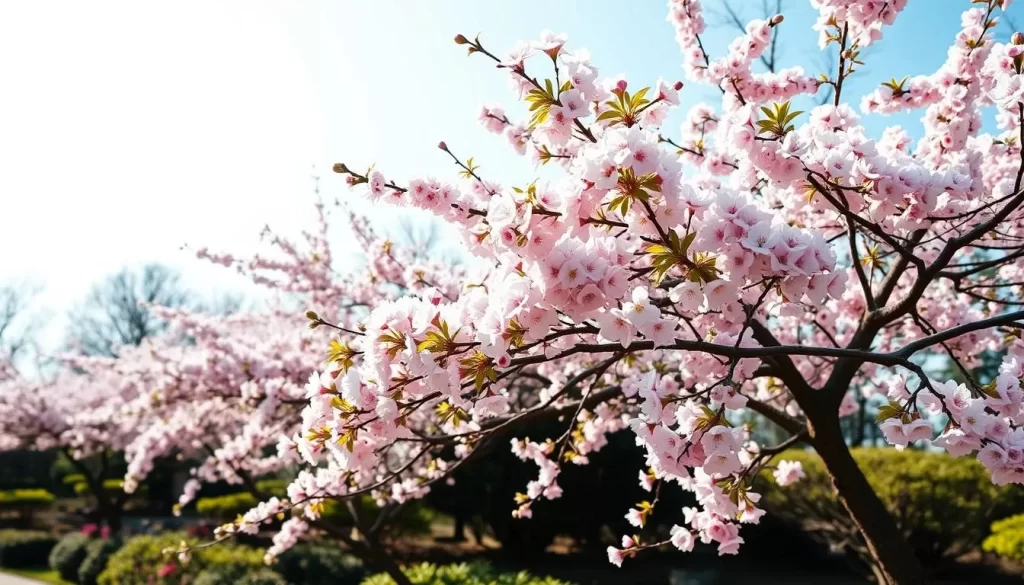
As you step into the Tsukuba Botanical Garden, you’re immediately enveloped in a world of natural beauty and tranquility. This botanical garden is a haven for nature enthusiasts and those seeking a peaceful retreat from the city’s hustle and bustle.
Diverse Plant Collections
The Tsukuba Botanical Garden boasts an impressive collection of diverse plant species. With a focus on conservation and education, the garden curates its collections to ensure visual interest throughout the year. Carefully planned succession planting and seasonal rotations mean that there’s always something new to discover. You’ll have the opportunity to explore a wide range of flora, from native Japanese plants to exotic species from around the world.
The garden’s diverse plant collections are not just visually stunning; they also play a crucial role in promoting biodiversity and supporting local ecosystems. By visiting the garden, you’ll gain a deeper appreciation for the importance of plant conservation and the role that botanical gardens play in protecting our natural heritage.
Specialized Greenhouses and Themed Areas
One of the highlights of the Tsukuba Botanical Garden is its array of specialized greenhouses and themed areas. These unique environments allow visitors to explore a variety of ecosystems, from tropical rainforests to arid deserts. Each greenhouse is carefully designed to replicate the conditions necessary to support a wide range of plant life, providing a fascinating glimpse into the diversity of our planet’s flora.
The themed areas within the garden are equally captivating, with carefully curated collections that showcase plants used for food, medicine, and other purposes. These areas not only educate visitors about the practical uses of plants but also highlight the intricate relationships between humans and the natural world.
Seasonal Highlights
The Tsukuba Botanical Garden is renowned for its spectacular seasonal highlights. In the spring, the garden comes alive with the delicate pink hue of cherry blossoms, a truly unforgettable sight. As the season changes, the garden transforms, with hydrangeas blooming in early summer and the foliage turning to rich golden and crimson colors in autumn. The garden’s curators carefully plan the planting to ensure that there’s something beautiful to see at any time of year.
Visitors can enjoy a month-by-month guide to what’s blooming, helping you plan your visit to coincide with your favorite flowers or experience the garden’s most photogenic season. The garden also hosts special seasonal events, including illuminations, guided walks, and workshops that celebrate nature’s changing displays.
Tsukuba Expo Center: Interactive Science Museum
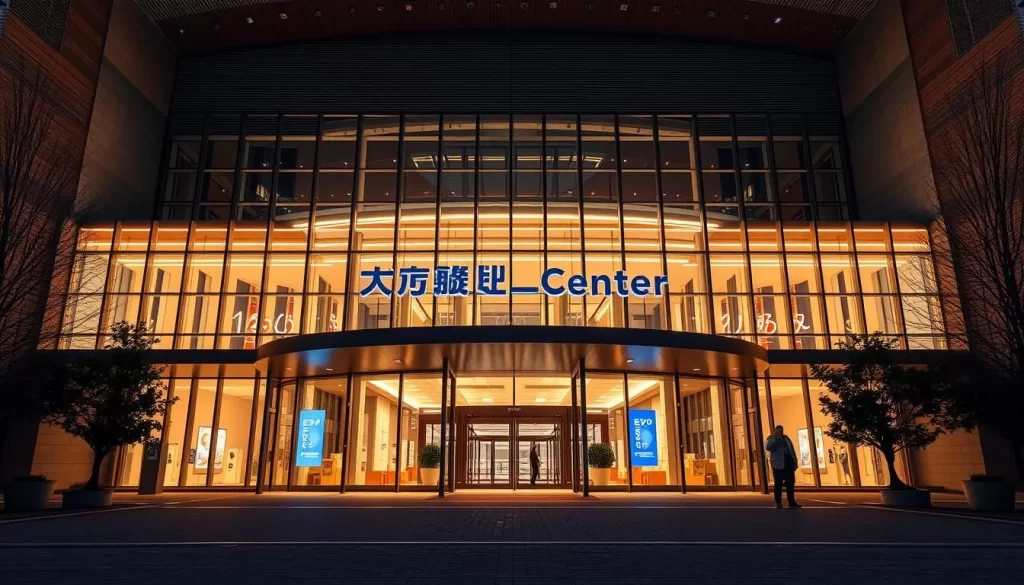
With its interactive science museum and planetarium, the Tsukuba Expo Center is an ideal place for families to spend a day exploring the wonders of science together. This center is designed to be an engaging and educational experience for visitors of all ages, making it a must-visit destination in Tsukuba.
Hands-On Exhibits and Demonstrations
The Tsukuba Expo Center boasts an impressive area dedicated to hands-on exhibits and demonstrations that allow you to explore scientific concepts in an interactive manner. From DIY experiments to live presentations, you’ll have the opportunity to engage with science in a fun and accessible way.
Some of the highlights include science workshops where you can participate in DIY experiments and craft sessions suitable for both children and adults. These activities are designed to foster a deeper understanding of scientific principles while encouraging creativity and curiosity.
Planetarium Shows
The planetarium at the Tsukuba Expo Center offers breathtaking shows that take you on a journey through the cosmos. With its advanced technology, you’ll be able to explore the wonders of the universe in a highly immersive environment.
These shows are not only entertaining but also educational, providing insights into various astronomical phenomena and the latest discoveries in space exploration.
Family-Friendly Activities
The Tsukuba Expo Center is committed to providing a welcoming environment for families. The dedicated children’s area is equipped with age-appropriate exhibits that introduce scientific concepts through play, ensuring that younger visitors have a enjoyable and enriching experience.
Throughout the day, the center hosts various science-themed games and competitions that encourage friendly family competition while reinforcing scientific principles. This balance of education and entertainment makes the Tsukuba Expo Center a top choice for family outings.
Doho Park: Relaxation in Nature
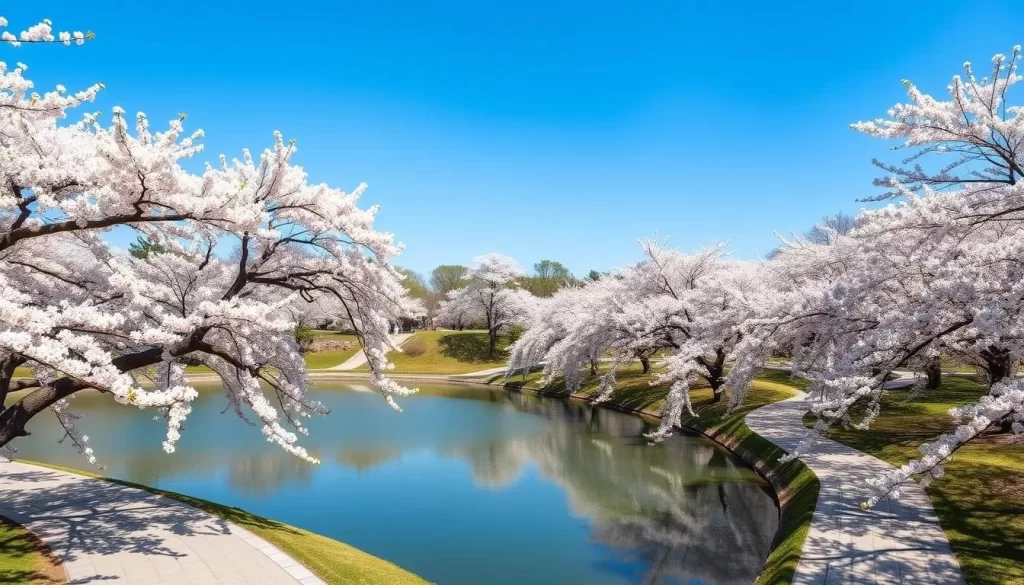
Nestled in Tsukuba, Doho Park is a haven for those seeking relaxation and a deep connection with the natural world. As you step into the park, you’re greeted by the soothing atmosphere that pervades throughout the grounds.
Scenic Walking Paths and Lake
Doho Park’s scenic walking paths are a major draw, inviting you to take a leisurely stroll around the picturesque lake. The paths are lined with beautiful trees that provide shade and a sense of tranquility. As you walk, the serene lake offers a reflective surface that mirrors the surrounding landscape, creating a sense of calm.
The lake itself is a highlight, with its calm waters providing a habitat for various aquatic life. The changing season brings different scenery, from the vibrant greenery of spring to the colorful foliage of autumn.
Recreational Facilities
Doho Park is not just about serene landscapes; it also offers various recreational facilities to enhance your visit. You can enjoy a range of activities, from picnicking to more adventurous pursuits, ensuring that there’s something for everyone at the park.
The facilities are designed to complement the natural beauty of the park, providing a comfortable and enjoyable experience. Whether you’re visiting with family or friends, you’ll find plenty of opportunities to create lasting memories.
Cherry Blossom Viewing Spots
One of the park’s most celebrated attractions is its cherry blossoms. During spring, the park transforms into a breathtaking spectacle as the blossoms bloom. The time of blooming varies slightly from year to year, but it’s typically around late March to early April.
You’ll discover why Doho Park ranks among Tsukuba’s premier cherry blossom viewing destinations, with hundreds of sakura trees lining the lakeshores and pathways. The famous “Sakura Tunnel” is a must-see, where blossoms create a pink canopy overhead. Enjoy hanami (flower viewing) in the park, taking in the beauty of the blossoms at the best time of day for photography and less crowded areas for peaceful appreciation.
Tsukuba Wanwan Land: Paradise for Dog Lovers

Imagine a place where over 500 dogs await your arrival, eager to play and cuddle – welcome to Tsukuba Wanwan Land. This unique destination is a paradise for dog lovers, offering an interactive experience that is both fun and memorable.
Interacting with 500+ Dogs
At Tsukuba Wanwan Land, you’ll have the opportunity to interact with over 500 dogs in a safe and welcoming environment. The facility is designed to allow visitors to play, cuddle, and even feed the dogs, creating a truly immersive experience. Whether you’re a dog owner or simply an animal lover, this is a chance to connect with these friendly creatures on a deeper level.
The dogs at Tsukuba Wanwan Land are well-cared for and socialized, making them receptive to visitors. You can expect to spend your time at the facility engaged in various activities with the dogs, from playtime to simply enjoying their company.
Animal Shows and Activities
In addition to interacting with the dogs, visitors can enjoy various animal shows and activities throughout the day. These events are designed to entertain and educate, showcasing the talents and abilities of the dogs. By timing your visit around these shows, you can make the most of your day at Tsukuba Wanwan Land.
The activities are suitable for visitors of all ages, making Tsukuba Wanwan Land a great place for family outings or social gatherings.
Visitor Information and Tips
To ensure a smooth and enjoyable visit, it’s essential to be aware of the practical information. Tsukuba Wanwan Land operates on a seasonal schedule: it’s open from 3/1-10/31, 10:00am-5:00pm; from 11/1-12/31, 10:00am-4:00pm; and from 1/1-2/29, 10:00am-4:00pm. The admission fee is 1500 JPY, and the recommended length of stay is between 1 to 3 hours.
Visitors are advised to wear comfortable, casual clothing suitable for animal interactions. While handwashing stations are available throughout the facility, bringing hand sanitizer is also a good idea. Some areas may require additional fees for specific activities, so it’s worth checking when you arrive.
By planning your visit according to the operating hours and taking advantage of the various activities, you can have a fulfilling experience at this unique place. Whether you’re looking to spend a leisurely day out or simply want to enjoy some quality time with dogs, Tsukuba Wanwan Land is an ideal destination for visitors of all ages.
Tsukubasan Shrine: Ancient Spiritual Site
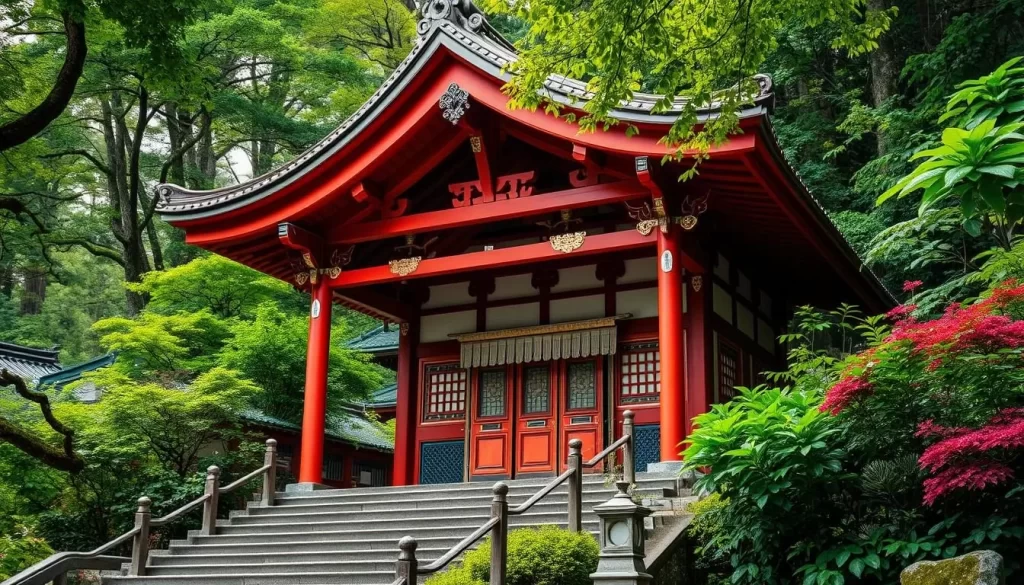
Tsukubasan Shrine, a sacred site nestled in the heart of Tsukuba, Japan, boasts a rich history spanning over 3,000 years. This ancient shrine is dedicated to the deities associated with Mount Tsukuba and has been a significant spiritual destination for centuries.
3,000 Years of History and Mythology
The history of Tsukubasan Shrine is deeply intertwined with the mythology of Mount Tsukuba. According to legend, the shrine was established to honor the deities that reside on the mountain. Over the centuries, it has played a crucial role in the spiritual lives of the local population, with records of its existence dating back to ancient times. You will discover the shrine’s fascinating history and the myths that have been passed down through generations.
Sacred Buildings and Structures
The shrine complex includes several sacred buildings and structures, each with its unique architectural style and historical significance. The main hall, for instance, is a beautiful example of traditional Japanese architecture, dedicated to the worship of the shrine’s deities. As you explore the complex, you’ll notice the intricate carvings and ornate details that adorn the buildings, reflecting the craftsmanship of ancient Japanese artisans.
Festivals and Cultural Events
Tsukubasan Shrine is not just a historical site; it’s a living, breathing part of Japanese culture, with numerous festivals and events taking place throughout the year. You’ll have the opportunity to attend festivals such as the Mount Tsukuba Fire Festival in March, where participants carry flaming torches up the mountain in a breathtaking nighttime procession. Other notable events include the Chrysanthemum Festival in autumn, showcasing elaborate flower arrangements, and the New Year celebrations, when thousands perform hatsumode (first shrine visit of the year) to receive blessings.
These cultural events connect modern visitors to ancient traditions, providing a unique insight into the continuing importance of Shinto practices in contemporary Japanese culture. By participating in or witnessing these festivals, you will gain a deeper understanding of the shrine’s significance and its role in the community.
Geological Museum: Earth’s Treasures
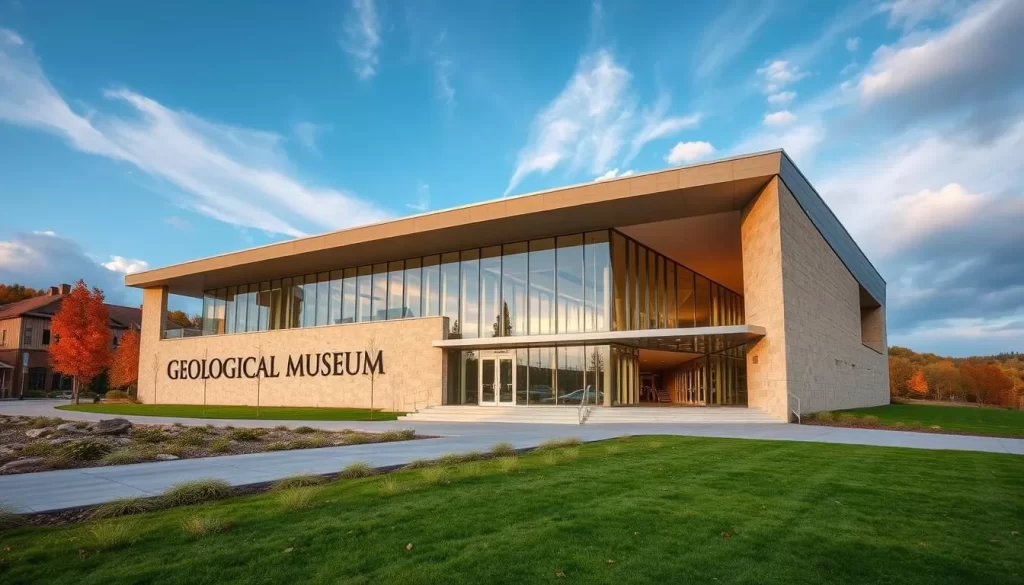
Tsukuba’s Geological Museum is a place where science comes alive, showcasing the Earth’s incredible geological history. As you step inside, you’ll be greeted by an impressive collection of geological wonders that will take you on a journey through the Earth’s formation and evolution.
Fossil Collections
The museum boasts an impressive array of fossils, including ancient creatures that once roamed the Earth. You’ll be amazed by the intricate details preserved in these fossils, offering a glimpse into the Earth’s past.
Some of the notable fossil exhibits include:
- Fossils of ancient marine life, showcasing the evolution of species.
- Plant fossils that highlight the Earth’s changing climate.
Mineral Displays
The museum’s mineral collection is another highlight, featuring a diverse range of minerals from around the world. You’ll be fascinated by the vibrant colors and unique structures of these minerals, each with its own story to tell.
As you explore the mineral displays, you’ll gain insights into the geological processes that form these minerals, enhancing your understanding of the Earth’s science.
Educational Exhibits
The Geological Museum offers a range of educational exhibits designed to engage visitors of all ages. You’ll have the opportunity to explore interactive displays that demonstrate complex geological concepts in an accessible way.
Some of the interactive exhibits include:
- A place to learn about plate tectonics through realistic models and animations.
- An earthquake simulation area where you can experience different magnitude earthquakes.
- Exhibits on volcanic activity that utilize cutting-edge technology to illustrate the processes beneath Japan’s volcanoes.
These exhibits not only educate but also entertain, making the Geological Museum a must-visit destination in Tsukuba.
Tsukuba, Japan: Best Things to Do – Top Picks for Foodies
Tsukuba’s diverse culinary landscape makes it a must-visit destination for any food enthusiast. The city offers a wide range of delicious local specialties, fresh produce, and unique dining experiences that are sure to satisfy any palate.
Local Specialties to Try
Tsukuba is renowned for its agricultural produce, including high-quality rice and seasonal fruits. When visiting, be sure to try some of the local specialties such as Ibaraki’s famous natto (fermented soybeans). You can find these products at various food markets and specialty shops throughout the city. Some popular items include:
- Fresh vegetables and fruits
- High-quality rice
- Ibaraki’s natto
- Seasonal fruits and delicacies
Exploring the local food scene is a great way to experience the culture and hospitality of Tsukuba. You’ll have the opportunity to taste a variety of dishes made with fresh, locally-sourced ingredients.
Top Restaurants in Tsukuba
Tsukuba is home to a variety of excellent restaurants serving everything from traditional Japanese cuisine to international dishes. Some top recommendations include eateries that specialize in local produce, offering a true taste of the area’s culinary delights. When planning your day in Tsukuba, consider visiting:
- Restaurants serving fresh, seasonal produce
- Eateries offering traditional Japanese dishes
- International cuisine options for a diverse dining experience
Dining in Tsukuba is not just about the food; it’s also about the place where you enjoy your meal. Many restaurants offer beautiful views or unique settings that enhance the overall dining experience.
Food Markets and Shops
For those looking to take a piece of Tsukuba back home, the city’s food markets and specialty shops are a great place to start. You can find a wide range of local products, including artisanal foods, traditional Japanese confectionery (wagashi), and other regional delicacies. Some highlights include:
- Vibrant farmers’ markets with fresh produce
- Specialty food shops with regional delicacies
- Department store basement food floors (depachika) with a variety of prepared foods and sweets
Visiting these markets and shops is a great way to experience the local food culture and find unique souvenirs to bring back home.

Cycling Through Tsukuba: Scenic Routes

Cycling in Tsukuba is an adventure that combines scenic views, cultural experiences, and technological marvels. With its diverse landscapes, ranging from urban scientific centers to rural farmlands and natural parks, Tsukuba offers a unique cycling experience.
Tsukuba Rinrin Road
The Tsukuba Rinrin Road is a notable cycling route that offers a delightful experience. This road is designed to provide cyclists with scenic views of Mount Tsukuba, particularly during sunrise or sunset. Along the way, you’ll find rest areas equipped with benches, vending machines, and restrooms, making your ride comfortable and enjoyable.
As you cycle along this route, you’ll be treated to panoramic vistas of the twin peaks of Mount Tsukuba. The route is well-maintained and suitable for cyclists of various skill levels.
Bike Rental Options
To explore Tsukuba’s cycling routes, you’ll need a bike. Fortunately, there are several bike rental options available in the area. Many rental shops offer a variety of bicycles, including road bikes, mountain bikes, and electric bikes, to suit different preferences and needs.
When renting a bike, consider the type of terrain you’ll be cycling on and the distance you plan to cover. Some rental shops also provide guided tours and cycling maps, which can be very helpful for first-time visitors.
Recommended Cycling Itineraries
Tsukuba offers several recommended cycling itineraries that cater to different interests. For those interested in nature and scenery, the route around Mount Tsukuba is a must-try. This half-day itinerary takes you through traditional villages and offers spectacular views of the twin peaks from various angles.
For a more technologically inclined experience, the “Science City Tour” route connects major research institutions and museums, providing insight into Tsukuba’s scientific and technological advancements. Alternatively, the “Park Hopper” route is perfect for families, linking Tsukuba’s major parks and green spaces via safe cycling paths with plenty of rest areas.
Seasonal Attractions in Tsukuba
The changing seasons reveal different facets of Tsukuba’s natural beauty and cultural heritage. As you plan your visit, you’ll find that each time of year offers unique experiences and attractions.
Spring: Cherry Blossom Viewing Spots
Spring is a beautiful time in Tsukuba, with the cherry blossoms blooming in late March to early April. Popular spots for cherry blossom viewing include Doho Park and the Sakura Namiki Street. The blossoms create a picturesque landscape, perfect for a leisurely stroll or a family picnic.
Tsukuba’s mild spring weather makes it an ideal time to explore the city’s outdoor attractions. You can visit the Tsukuba Botanical Garden, which features a variety of plant species, or take a hike on Mount Tsukuba’s lower trails.
| Location | Best Time to Visit | Notable Features |
|---|---|---|
| Doho Park | Late March to early April | Sakura Namiki Street, picnic areas |
| Tsukuba Botanical Garden | Spring | Diverse plant collections, specialized greenhouses |
| Mount Tsukuba | Spring | Hiking trails, scenic views |
Summer: Festivals and Outdoor Activities
Summer in Tsukuba brings warm weather and a range of outdoor activities. You can enjoy hiking on Mount Tsukuba or explore the city’s many parks and gardens. The Tsukuba Expo Center hosts various events and exhibitions during the summer, making it a great place to visit with family.
The city’s summer festivals, such as the Tsukuba Festival, offer a glimpse into local culture, with traditional food, music, and dance performances.
Fall: Autumn Foliage Locations
Autumn in Tsukuba is characterized by vibrant foliage, making it a popular time for leaf viewing. Doho Park and the surrounding areas are particularly beautiful during this season, with the changing leaves creating a kaleidoscope of colors.
You can take a leisurely walk or bike ride along the Tsukuba Rinrin Road, which offers scenic views of the autumn foliage.
Winter: Cold Season Experiences
Winter brings a serene beauty to Tsukuba, with Mount Tsukuba occasionally transforming into a winter wonderland. While the snowfall is not heavy, the landscape takes on a peaceful quality, ideal for winter photography.
Indoor attractions like the Tsukuba Space Center and the Geological Museum offer engaging activities during the colder months. You can also relax at one of the nearby hot spring facilities.
Tsukuba’s winter illumination events and seasonal decorations add to the city’s charm, making it a lovely place to visit even in the cold season.
Day Trips from Tsukuba
Tsukuba’s strategic location makes it an ideal base for exploring the diverse attractions of Ibaraki Prefecture. The surrounding area is filled with exciting experiences that can be enjoyed on a day trip, making it easy to discover new places and enjoy the local culture.
Tsuchiura City and Lake Kasumigaura
One of the most interesting places to visit near Tsukuba is Tsuchiura City, located on the shores of Lake Kasumigaura, Japan’s second-largest lake. You can enjoy a leisurely stroll along the lake’s shoreline, visit the Tsuchiura Castle remains, or take a boat tour to appreciate the natural beauty of the area. The city also offers a variety of local cuisine, including fresh seafood from the lake.
A short drive or train ride from Tsukuba, Tsuchiura City is easily accessible for a day trip. The city’s historical significance and natural beauty make it an attractive destination for those looking to explore beyond Tsukuba.
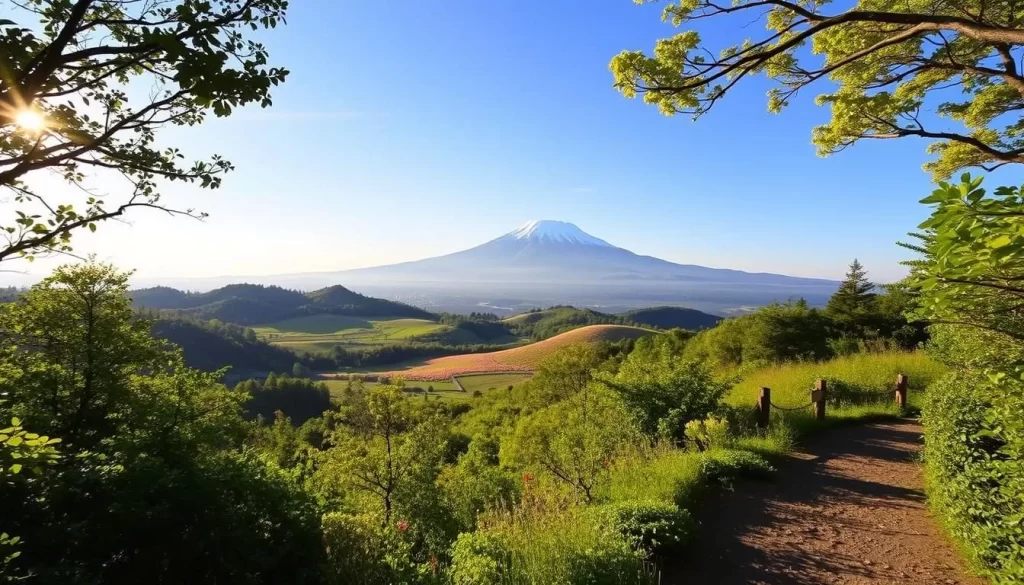
Ami Premium Outlets
If you’re looking for a more leisurely day trip, consider visiting the Ami Premium Outlets, a popular shopping destination located near Ami Town. The out-lets offer a wide range of high-end and brand-name goods at discounted prices, making it an ideal place to pick up souvenirs or enjoy some retail therapy.
In addition to shopping, the Ami Premium Outlets also feature a variety of dining options, from casual eateries to more upscale restaurants. You can make a day of it by combining shopping with a meal or snack at one of the on-site eateries.
Other Nearby Attractions
Beyond Tsuchiura City and Ami Premium Outlets, there are numerous other attractions to explore in the region. For instance, you can visit Ushiku Daibutsu, one of the world’s tallest bronze Buddha statues, standing at an impressive 120 meters. The statue is not only a significant spiritual landmark but also offers panoramic views from its observation deck.
Other highlights include Hitachi Seaside Park, known for its stunning seasonal flower displays, and Kasama, a historic pottery town where you can experience traditional Japanese ceramics. You can also explore the samurai heritage district of Sakura City, featuring well-preserved historical buildings and the impressive Sakura Castle Park. By combining these attractions into your itinerary, you can create a memorable day trip from Tsukuba.
Practical Information for Visiting Tsukuba
For a hassle-free trip to Tsukuba, understanding the basics of getting there, getting around, and where to stay is vital. As you plan your visit, having the right information will make a significant difference in your travel experience.
How to Get to Tsukuba from Tokyo
Tsukuba is easily accessible from Tokyo, making it an ideal day-trip or short-stay destination. The most convenient way to reach Tsukuba is by taking the Tsukuba Express train from Akihabara Station in Tokyo. The journey takes approximately 45 minutes, and trains run frequently throughout the day.
Getting Around Tsukuba
Once you arrive in Tsukuba, getting around the city is relatively straightforward. The city offers various transportation options, including buses and taxis. For visitors, renting a bike is also a great way to explore Tsukuba, as the city is relatively flat and has designated bike paths.
Where to Stay in Tsukuba
Tsukuba offers a range of accommodation options to suit different budgets and preferences. From luxury hotels to budget-friendly guesthouses, you’ll find a place to stay that meets your needs. Some popular hotels in Tsukuba include those near the city center or close to major attractions.
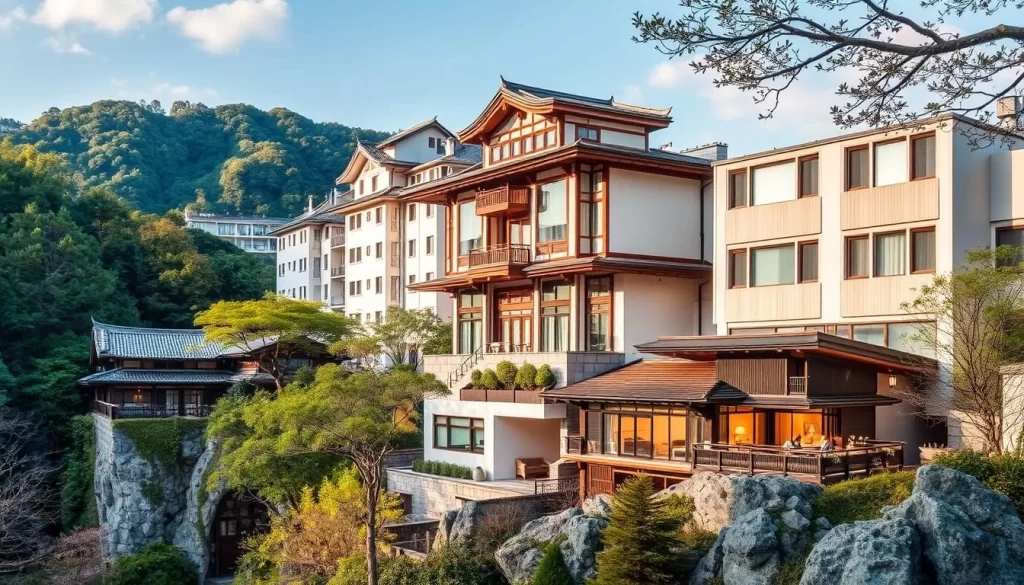
When choosing where to stay, consider the location and its proximity to the attractions you plan to visit. Staying near the Tsukuba Station can be convenient, as it provides easy access to various parts of the city.
Travel Tips and Etiquette
When visiting Tsukuba, it’s essential to be mindful of local customs and etiquette. For example, when visiting shrines or temples, dress modestly and follow any rules or guidelines provided by the staff. Additionally, being respectful of the local environment and other visitors will enhance your experience and that of those around you.
Some practical tips for visitors include wearing comfortable shoes, as you’ll likely be doing a lot of walking. It’s also a good idea to pack layers, as the temperature can vary significantly between indoor and outdoor locations.
Conclusion: Making the Most of Your Tsukuba Adventure
As a hidden gem in Japan, Tsukuba awaits your visit with its rich heritage and modern attractions. You’ll now have a comprehensive understanding of Tsukuba’s unique appeal as a destination that perfectly balances cutting-edge science with natural beauty and cultural heritage.
We’ve guided you through the must-see attractions, from the sacred twin peaks of Mount Tsukuba to the futuristic displays at JAXA Space Center and the tranquil beauty of botanical gardens and parks. You’ve discovered how Tsukuba offers experiences for every interest, whether you’re fascinated by scientific innovation, drawn to outdoor adventures, or seeking cultural and spiritual enrichment.
To make the most of your time in Tsukuba, we’ve provided practical information to help you plan your visit efficiently, including transportation options, accommodation recommendations, and insider tips. This place deserves a spot on your Japan itinerary—as either a rewarding day trip from Tokyo or a multi-day destination that reveals a different side of Japan beyond the typical tourist trail.
In Tsukuba, you’ll find a unique blend of modern and traditional experiences that make it a memorable place to visit. With its diverse attractions and activities, Tsukuba is sure to leave a lasting impression on your travels in Japan.
The above is subject to change.
Check back often to TRAVEL.COM for the latest travel tips and deals.
